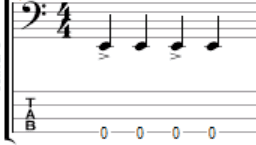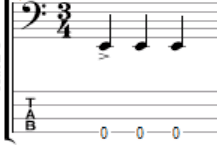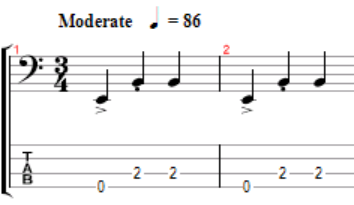There is nothing unnatural about playing bass in 3/4 time. However, this time signature can feel awkward at first since we are all so used to playing in 4/4 time. It`s also easy to form bad habits if you try too hard to play the right notes, without getting a feel for the time.
Therefore, I decided to write this guide on how to approach the 3/4 time signature as a bass player.
I`ll start by covering the basics of how 3/4 works and how to get a feel for it. Then, we will move on to how to play basslines, where I`ve added a couple of exercises that will help you get started.
Lastly, I`ve made a list of songs that are played in 3/4. With it, you can both get a better feel for the time signature and how it’s used in various forms of music.
Understanding 3/4 time as a bass player
Time signatures are used to measure how we count the notes inside a bar of music.
They are presented as two numbers. The first of these shows how many beats there are in the bar. The second shows what type of note to use for counting these beats out.
In 4/4 time, the first number tells us that there are 4 beats in a bar. The second number tells us that these should be counted as quarter notes.

In the 3/4 time signature, the first number indicates that there are 3 beats in a bar. The second number indicates that we need to count these as quarter notes.

A bass groove in 4/4 time has to last 4 quarter notes for each bar. We can divide these notes however we want. We could fill a bar with 2 half notes, a half note and 2 quarter notes, or of course, 4 quarter notes:

A bass groove in 3/4 time only has space for 3 quarter notes in each bar. We can again divide these notes how we want, but we won`t have as much space as in 4/4 time. For example, we could play a half note and a single quarter note, or 3 quarter notes:

Because of this, different time signatures all have different pulses and rhythms to them.
In the examples above, you will see some notes have an arrowhead beneath them. This means the notes are accented. Accenting means that we put more emphasis on them, which in turn makes the notes easier to count.
The 4/4 example can thus be counted as One-two-Three-four, with the 1. and 3. beat feeling strong, and the 2. and 4. beat feeling weak.
However, this counting pattern cannot be repeated in 3/4 time. If we tried, it would go “One-two-Three-One-Two-Three”.
This would change the emphasis of the note between bars, which feels awkward and unnatural. Instead, the bar is counted as “One-two-three-One-two-three” in the example.
The result of this is that 3/4 time both sounds and feels different from 4/4. It`s also the reason different time signatures can be used to write vastly different songs within the same genres.
Learning to play bass in 3/4 time
The 3/4 time signature has its origins in continental folk music. One form of music from this tradition that many are still familiar with today is the waltz.
3/4 time is often referred to as “waltz rhythm”. It also uses the same “One-two-three” accenting as in the example above.

Waltz`s are also relatively slow, tending to range from 85 to 90 BPM. This makes them perfect for learning to play the bass in 3/4 time.
As we proceed, I recommend putting on a metronome. This is because chances are good that you will naturally gravitate more towards a 4/4 rhythm when starting out. A metronome will thus help ground you in 3/4 time and make it more natural to follow along with it.
With that said, here are some simple waltz-type exercises to get you started. At first, try to play them at around 86 BPM.



I recommend going at these until you can comfortably play all three of them. While doing so, focus on getting a feel for the rhythm, more so than just playing the right notes.
It is perfectly possible to play these lines correctly while still thinking about them in 4/4 time. However, this will impact how you emphasize the notes, and can often lead to the pulse of the bassline sounding awkward. Not getting a proper feel for the 3/4 pulse will also make it more demanding to play more demanding basslines down the line.
Therefore, listen to the metronome, and preferably count the beats out loud as you play them.
When you get comfortable with this, you can move on to practicing songs by your favorite artists. Thus, let’s move on by taking a look at some popular songs that are played in 3/4 time.
What basslines are played in 3/4 time?
In addition to waltz, you will find 3/4 used in a lot of contemporary music. It`s not nearly as widely used as 4/4, but it is the second most common time signature out there.
You will find it in rock, pop, metal, jazz, and everything in between. To illustrate this, here is a list of some well-known modern songs, which are all played in 3/4:
| Song in 3/4 Time | Band | Bass Player |
| Norwegian Wood | The Beatles | Paul McCartney |
| Manic Depression | Jimi Hendrix Experience | Noel Redding |
| Nothing Else Matters | Metallica | Jason Newsted |
| Satelite | Dave Matthews Band | Stefan Lessard |
| Kashmir | Led Zeppelin | John Paul Jones |
| Lonely Day | System Of A Down | Shavo Odadjian |
| Everybody Hurts | R.E.M | Mike Mills |
| Take It To The Limit | The Eagles | Randy Meisner |
| Take This Waltz | Leonard Cohen | Peter Kisilenko |
| Blackout | Muse | Chris Wolstenholme |
| The Millionaire Waltz | Queen | John Deacon |
| Blood Brothers | Iron Maiden | Steve Harris |
While these basslines vary in difficulty, I do recommend choosing a band or artist you like and trying to cover the song.
There are several reasons for this. First of all, it will be significantly more fun to practice playing in 3/4 this way than by repeating exercises. You will also see how the time signature is used in the types of music that you like, and get to put the basics of what you’ve learned into action.
Conclusion
Playing bass in 3/4 time is all about getting a feel for the rhythm and stopping yourself from thinking in 4/4 time. It also makes for a great exercise to develop your overall sense of time as a bassist.
When learning to play in 3/4 time, it is thus a best practice to use a metronome. For the same reason, I also recommend counting out the beats as you play them.
Getting a feel for the time becomes easier when you accent a beat. Usually, I find it the easiest to accent 3/4 basslines “One-two-three-One-two-three”.
As you start practicing various 3/4 songs, you might find that they call for a different pace than this. For example, you might find yourself counting “one-two-Three-one-two-Three” or “One-and-Two-and-Three-and-One-and-Two-and-Three-and”.
As long as it feels natural and you are staying on time, this is perfectly fine to do. When starting out though, I recommend mastering the “One-two-three” pulse and applying this to the waltz exercises above.

